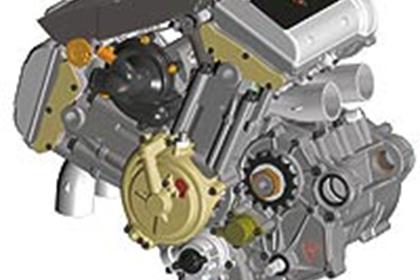Ducati reveals plan for V4 engine
Ducati has broken with its V-twin tradition with its proposed GP engine: It’s going to be a V4.
And while company bosses were giving little away when they released the news at 3pm CET on February 4, it is thought the V4 four-stroke could inspire at least one new road bike and perhaps a whole new series.
At the moment though, the firm is concentrating on developing the 989cc engine to race in the new four-stroke GP class. Ducati reckons its new ” Desmosedici ” motor will feel and sound like a twin thanks to an unusual design, which sees the two cylinders in each bank firing together in pairs.
Ducati reckons it could give its GP bike the same sort of advantage in terms of traction and drive out of corners as its 998 WSB machine enjoys on the track.
Ducati was forced to opt for four cylinders rather than two by the need to be able to at least match the 220bhp power outputs claimed by most of its four-stroke GP rivals. Claudio Domenicali, MD of Ducati Corse, the firm’s racing arm, said: ” After analysing all the possibilities offered by the regulations and on the basis of computer simulations, we are convinced that a massive power output is required to be competitive in MotoGP. It would have been difficult to obtain this power with conventional twin-cylinder engines, which are only given a 10kg weight advantage over four and five cylinder engines in the GP regulations.
” As a result, the bore size would have to be taken to an extremely high value, with the risk of incurring serious combustion problems. ”
Ducati settled upon the V4 idea – or ” double-twin ” . Because the pistons fire in pairs, the engine should sound like a V-twin – and as an extra bonus it should give more traction than a conventional four.
The theory is the same as that used on ” big bang ” two-stroke GP bikes.
Domenicali said: ” We designed an engine with four round pistons which, thanks to a simultaneous two-by-two firing order, reproduces the working cycle of a twin. This will generate the ‘big bang’ effect, making the rear tyre work in a way that extends its duration and improves rider feeling when exiting the curves. ”
The theory sounds good – but it has yet to be proved, as so far Ducati hasn’t built a running version of the engine. It plans to begin bench tests in May and hopes to have a bike testing on the track by July. The actual bike will follow Ducati tradition, with a trellis frame rather than the more conventional aluminium beam chassis, and its bodywork will be designed by Ducati’s in-house team headed by Pierre Terblanche.
He told MCN: ” So far, I have not had much involvement with the project, but I expect we will be working on the bike’s styling and aerodynamics soon. ”
Terblanche will be getting a helping hand on the bike’s aerodynamics from British ex-Formula 1 designer Alan Jenkins, who had a glittering career as a designer and aerodynamicist with teams like McLaren, Arrows and Stewart. He left F1 in 2000 after being sacked by the Prost team, and has since been seen at GPs and WSB events doing research into bike design.
MUCH MORE ON THIS IN MCN, ON SALE ON WEDNESDAY, FEBRUARY 6, 2002
This story was first released to MCN2U subscribers at 2pm (GMT) on Monday, February 4, 2002. Were you among the first to know? Find out how you could be by following the link, right.


